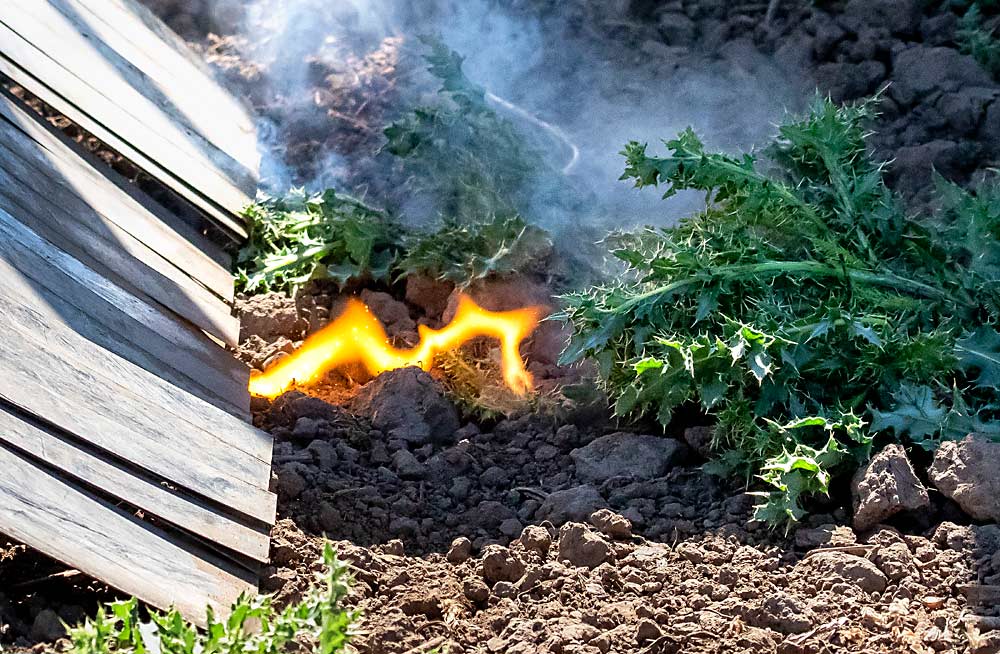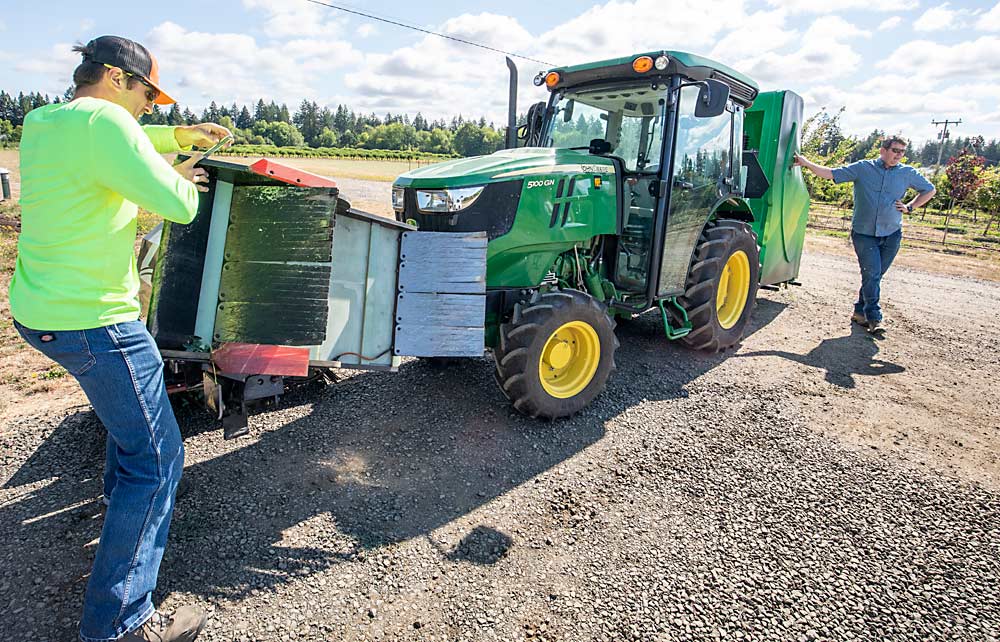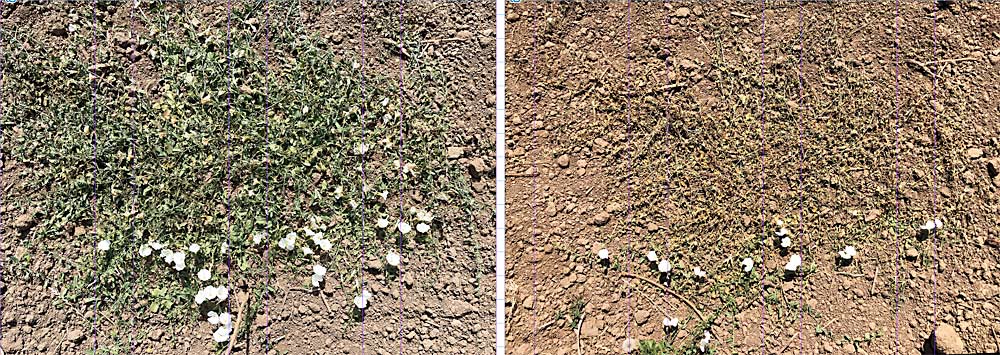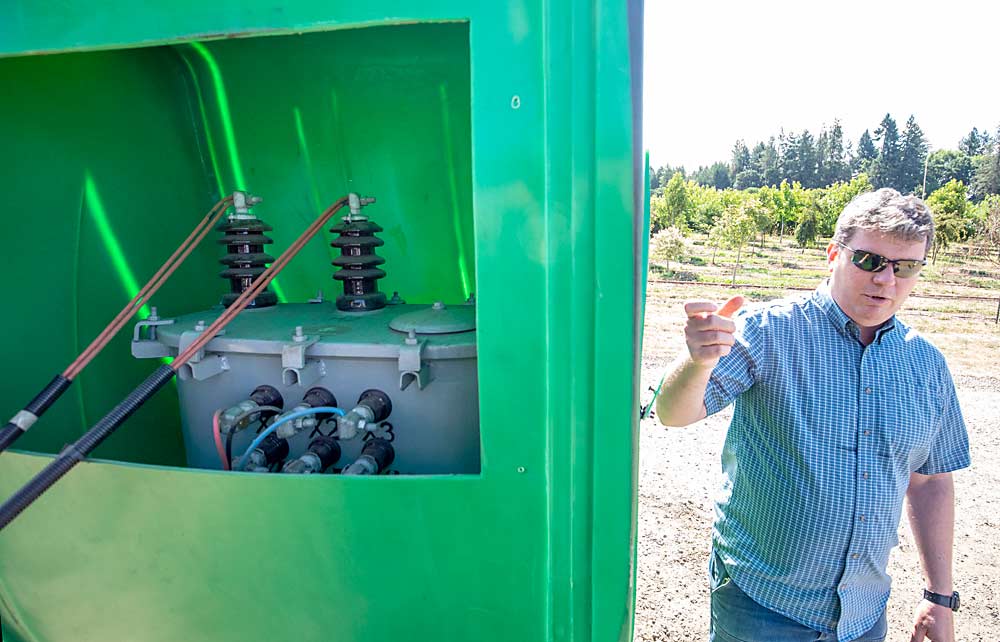
This approach to weed control is not for the faint of heart.
With a high-voltage transformer pulled behind a tractor, the electrical current sent into the soil makes the weeds sizzle and fry.
The technology, developed by Zasso, is not yet commercially available in the U.S., but Oregon State University weed scientist Marcelo Moretti imported a device from Brazil at the height of the pandemic. Zasso, now headquartered in Switzerland, offers several models of its technology for different crop systems in the European market.
Last summer, Good Fruit Grower watched a demonstration in a weedy field at OSU’s research farm in Corvallis.
“This is the first time I can, with no chemicals and no tillage, reach the roots,” Moretti said. The technology shows potential for vexing perennial weeds in organic systems or weeds that have developed herbicide resistance. The roots act as a ground wire, carrying the electricity applied at the surface through the root system, often killing the entire weed. “This will have huge traction in organics, I have no doubt.”
Preliminary trials show it’s effective against most weeds — the exception being the woody Himalayan blackberry, Moretti said. That suggests it’s likely safe to use in berry crop systems, though more research is planned to find out.

Moretti recently landed a $2 million grant from the U.S. Department of Agriculture’s Organic Agriculture Research and Education Initiative to begin testing the technology in blueberries. His collaborators, Lynn M. Sosnoskie of Cornell University and Brad Hanson of the University of California, Davis, will also test the technology in apples and almonds, respectively.
“We’re all honored to have the opportunity to investigate this,” Sosnoskie said. “We’re excited to see what it can do, but we’re also excited to look at it critically.”
The idea of using electric current to fry weeds isn’t new; the first patent for the idea dates back to 1890, Moretti said. Early approaches were outmatched by the ease and efficiency of modern herbicides, but growing herbicide resistance and interest in organics has renewed the attention.
Similar technology developed for row crops, such as soybeans, strikes weeds that grow taller than the crop, using a charged bar that runs above the crop, Sosnoskie said. But this Zasso model, developed for permanent crop systems, looks more like a mower and puts the current under the crop canopy.
While the project focuses on organic systems, she said there’s also great opportunity in conventional systems where growers are limited by herbicide resistance or regulations.
The researchers first aim to understand how best to optimize the technology: the ideal application speed, the number of passes needed, the optimum timing, interaction with the weed fabric common in organic blueberry systems, and so on.
“The performance depends on weed species, weed size, weed density and soil conditions such as soil texture and soil moisture,” Moretti said.

Soil type matters because sandy soils, with bigger pores and less water-holding capacity, are less likely to conduct electricity away from the roots, where it is most needed to be effective. Moretti said it will be important to test the technology locally.
Weed size and density also matter because the machine emits a consistent current through a closed circuit — from the electrode at the front of the applicator, through the soil, to the electrode at the back of the applicator. Any plant inside that loop will be hit with the current. Fewer weeds means each weed receives a greater jolt. Denser weeds would require the machine to move more slowly to more thoroughly distribute a lethal load of energy. It might be more efficient to pair the electric control technology with mowing first, to reduce biomass, or plan multiple, faster passes, Moretti said.
“If you can prepare the ground to get the most out of your electrical energy, it might be more efficient,” he said. “A good portion of the cost is the guy behind the wheel. If he can go 3 mph versus 1 mph, you just saved a lot of money.”
Following this first year of trials, the researchers plan to partner with growers to understand how the technology performs in a field context. Economists collaborating under the grant will ultimately evaluate the value of the electrical approach.
T.J. Hafner, an agronomy manager with AgriCare in Salem, Oregon, volunteered some of the blueberries he manages for the trial. He’s both intrigued and skeptical of the technology.
“We manage a substantial amount of organic blueberries, and every acre has weed fabric on it. If it were safe to use (the Zasso technology) along the edge of the weed fabric, like conventional growers do with herbicides, that would make mowing easier,” he said.
Replacing the weed fabric entirely with electricity would be even more impactful, Hafner said, saving farms the expense of the material, the labor needed to move it for nutrient applications, and the vole problems that weed fabric invites. But he needs to understand both the worker safety implications and the long-term impacts on crop and soil health.

“We’re willing to work with him to see if it’s effective,” he said. “We try to be innovative, and Marcelo aligns with that. He’s looking outside the box for new organic tools.”
The research team also plans to regularly test soil health and evaluate growth of the fine roots that do much of the nutrient and water uptake. Blueberries, with their shallow, drip-irrigated roots, offer an ideal test crop to assess the safety of the approach, Moretti said.
“If we are safe (using it) in blueberries, we should be safe on apples, on cherries and on pears,” he said. “That’s the hypothesis.”
—by Kate Prengaman






Leave A Comment